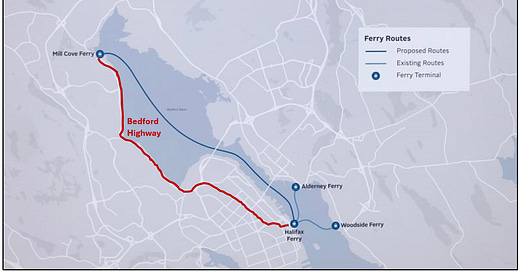A couple weeks ago, officials made a funding announcing for the Mill Cove ferry. Unlike the existing ferries, the new fast ferries will have a long 10 kilometer route, ushering users from Bedford all the way to downtown Halifax, avoiding the dreaded Bedford Highway (which isn’t really a highway).
At a very high level, there is a logic here - the Bedford highway has serious congestion issues. With a 18-minute ferry time, the ferry can deliver serious time savings, especially at peak hours (up to 20 minutes, and more on bad days).
Even if you add a median wait time of 7.5 minutes (given 15-minute ferry frequency) at rush hour, there will be peak hour time savings vs. driving.
So is the ferry plan a good one?
Cost Sharing
One of the key things to consider in these types of projects is cost sharing. Of the $258 million project cost, a majority will come from the feds, with another chunk from the province. If you do some simple attribution (based on Halifax’s population), you could say Halifax taxpayers will only pay ~$70m for this $258m project (and HRM directly only pays $38m).
Obviously, this level of cost-sharing makes projects almost always a “good deal”. Everyone likes paying for stuff we want with Other Peoples Money^tm. It’s not a waste of our money as Haligonians. Cost-sharing also incentivizes Halifax to try to stuff in other things we want into this project1.
The Problem(s)
The latest projections I can find expect the ferry to carry 3,080 passengers. I’m not 100% sure on this, but I suspect that is per direction2.
The same report expects 1,800 users to come from current bus users, and 1,280 to come from drivers. The problem is that the current site plan only expects 175 parking spots. That leaves over a thousand current drivers would need to find a way to and from the ferry terminal.
That means they’d need to park somewhere else, or get a drive to the terminal (a spouse or Uber).
I am skeptical of those non-parked drivers converting. The Bedford / Sackville catchment area is overwhelmingly (~90%) a “drive to work” region.
Driving is not just about travel times, the wait times matter, and so do (bus) connections, as well as the potential for intermediary stops (like picking up groceries on the way home).
The lack of parking, and the “potential users” unfamiliarity with taking the bus (to Mill Cove or from downtown to a final destination destination) suggests to me serious risk of missing ridership numbers. The irony is that these drivers are the folks who need to shift over if Bedford Highway congestion is to be alleviated.
Maybe in the future, Halifax Transit will improve “the first/last mile” bus connections, especially with Bus Rapid Transit (the other transit plan that could’ve been funded). But for now, and in keeping with other infrastructure forecasts, I suspect we have some optimism bias.
Because this is Deny’s Hot Takes, and the chances to take actual forecasts about the future is rare, I will provide my own ridership adjustments.
I’ve given full credit to the 175 parking stalls
I’ve haircut the bus transfers by 30%3
I’ve haircut the unparked drivers by 75%
That leaves daily ridership at just above half of the expected figures. This would be about half the Alderney ferry and 25% less than Woodside4 (pre-Covid). We will see in a few years how it turns out!
So would it be a flop?
I’m skeptical that this will be great alternative for many daily commuters. But it can still be viewed as a success. I think the ferry will be a big hit for one-off events: Mooseheads games, concerts, summer weekends, holidays and parades. In these moments, parking downtown is a hassle, a uber home from the terminal might be fine, and not driving means you can have another drink.
On these occasions, the ferry will be a super convenient choice for many. These one-off days may be enough that the broad majority considers the ferry a success, even if it doesn’t change commuting patterns or reduce congestion on the Bedford highway. I suspect that is partially (the political reasoning) why this ferry got the nod over a more tangible improvement to Halifax’s bus system.
The new ferry terminal will have a library included, and for parking reasons, this appears to basically be HRM trying to offload investments it should be making onto other levels of government.
Mostly because otherwise the peak hour ridership (570) would be too high relative to daily (3080/2 = 1540). It’s highly unlikely that a single hour carries a more than third of the daily total.
I think whatever modelling was done likely overestimates the longer, end-to-end travel demand. e.g., a bus user from Bedford going to Dalhousie or the Halifax Shopping Centre
Being worse than Woodside makes me think I’m being too harsh…but we’ll see












Deny,
Some good data to know. Parking is the issue for this to work and pay for its self for the next fifty years.
Can see if we can level Sunnyside mall and all the home on the on the opposite side of the river bank? A possible tram line road.
How many cars would fit in the mall flood plain?
Can a electric tram move people to ferry with a walking park to joint the Bedford park?